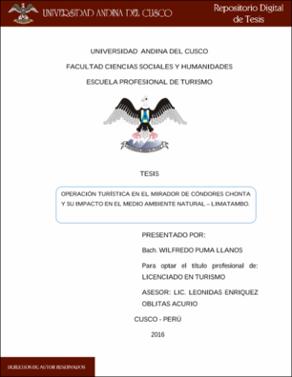| dc.contributor.advisor | Enriquez Oblitas Acurio, Leonidas | |
| dc.contributor.author | Puma LLanos, Wilfredo | |
| dc.date.accessioned | 2016-11-11T17:01:45Z | |
| dc.date.available | 2016-11-11T17:01:45Z | |
| dc.date.issued | 2016-06-03 | |
| dc.identifier.uri | https://hdl.handle.net/20.500.12557/454 | |
| dc.description.abstract | Los impactos en el aspectos turísticos son inevitables, sean aspectos positivos y/o negativos, dentro de los aspectos positivos están que el turismo es una actividad que genera movimiento económico, utilizando servicios colaterales a su propio interés de visitar un lugar, es decir utilizar medio de transporte, utilizar servicio de porteadores como compra de productos hasta otro tipo de insumos consumibles por el turista.
Entre los impactos negativos el principal está en la acumulación de basura y destrucción de medio ambiente en el cual no solo participa el turista sino los mismos encargados de prestar el servicio. En el caso particular de Limatambo se puede considerar como ventajas el incremento de albergues, pequeños restaurantes, guías locales especializados y pequeños puntos de venta de agua, frutos o algunos insumos que el turista (visitante) pueda requerir. Desde nuestro punto de vista, sería lo más conveniente una coordinación entre el sector público y privado para realizar el aporte correspondiente tanto económico, cultural y socialmente para la implantación y poner en valor de este mirador ecológico, dicha alternativa turística,
El siguiente trabajo está dividido en cinco capítulos.
Capítulo I. Problema objetivo de la investigación, formulación de los problemas, problema general y específico, objetivo general y específico, justificación limitación de la investigación. Capítulo II. Se encuentra el marco teórico, marco conceptual tenemos, marco legal, hipótesis general y específica, sistema de variables, operativa de variables y estado de arte que permitieron direccionar la investigación. Capítulo III. Tratamos la metodología de investigación, tipo de investigación. Capítulo IV. Damos a conocer el análisis e interpretación de los resultados. Capítulo V. Discusión y propuesta de investigación.
Al finalizar el trabajo de investigación se ha arribado a las conclusiones, recomendaciones, se adjuntan anexos y bibliografía consultada para el presente trabajo de investigación. | es_PE |
| dc.description.abstract | Impacts on tourism aspects are inevitable, whether positive and / or negative, within the positives are that tourism is an activity that generates economic movement, using collateral services to their own interest to visit a place that is used medium transport, use carrier service as purchasing products to other consumable supplies for the tourist.
Among the main negative impacts is the accumulation of waste and destruction of the environment in which not only tourists but part responsible for providing the same service. In the particular case of Limatambo it can be considered as benefits increased shelters, small restaurants, specialized local guides and small outlets of water, fruit or some inputs that tourists (visitors) may require. From our point of view, it would be more appropriate coordination between the public and private sector to make the corresponding contribution both economically, culturally and socially to implement and enhance the value of this ecological viewpoint, this alternative tourism,
The following paper is divided into five chapters.
Chapter I. Problem objective of the research, formulation of problems, general and specific problem, general and specific objective justification limiting research. Chapter II. The operational variables and state of the art theoretical framework, we have conceptual framework, legal framework, general and specific hypotheses, system variables, which allowed research is addressing. Chapter III. We try the research methodology, type of research. Chapter IV. We report the analysis and interpretation of results. Chapter V. Discussion and research proposal.
Upon completion of the research work has reached the conclusions, recommendations are attached annexes and consulted for this research literature. | en_US |
| dc.description.uri | Tesis | es_PE |
| dc.format | application/pdf | es_PE |
| dc.language.iso | spa | es_PE |
| dc.publisher | Universidad Andina del Cusco | es_PE |
| dc.rights | info:eu-repo/semantics/openAccess | es_PE |
| dc.rights.uri | https://creativecommons.org/licenses/by-nc-nd/2.5/pe/ | es_PE |
| dc.source | Universidad Andina del Cusco | es_PE |
| dc.source | Repositorio Institucional - UAC | es_PE |
| dc.subject | Operadores | es_PE |
| dc.subject | Impacto | es_PE |
| dc.subject | Medioambiental | es_PE |
| dc.title | Operación turística en el Mirador de Cóndores Chonta y su impacto en el Medio Ambiente Natural - Limatambo. | es_PE |
| dc.type | info:eu-repo/semantics/bachelorThesis | es_PE |
| thesis.degree.name | Licenciado en Turismo | es_PE |
| thesis.degree.grantor | Universidad Andina del Cusco. Facultad de Ciencias y Humanidades | es_PE |
| thesis.degree.level | Titulo Profesional | es_PE |
| thesis.degree.discipline | Turismo | es_PE |


